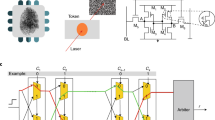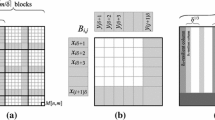Abstract
The trace-back technique is an effective approach for survivor memory management in the Viterbi algorithm. It is especially attractive when the number of states in the trellis is large, in which case the register exchange approach is impractical due to the area required for wiring. Previous descriptions of the trace-back technique have assumed either one or two trace-back pointers and have made specific assumptions about the speeds of those pointers. In this paper we present a general framework for implementing the trace-back technique with any number of trace-back pointers and with relaxed assumptions about the speeds of the pointers. We also show that the use of additional trace-back pointers reduces the memory requirements. Two implementations of the generalized trace-back techniques based on standard RAMs and custom shift registers are presented.
Similar content being viewed by others
References
A.J. Viterbi, “Error bounds for convolutional codes and an asymptotically optimum decoding algorithm,”IEEE Trans. Information Theory, vol. IT-13, 1967, pp. 260–269.
J.K. Omura, “On the Viterbi decoding algorithm,”IEEE Trans. Information Theory, vol. IT-15, 1969, pp. 177–179.
G.D. Forney Jr., “Maximum-likelihood sequence estimation of digital sequences in the presence of intersymbol interference,”IEEE Trans. Information Theory, vol. IT-18, 1972, pp. 363–378.
G.D. Forney Jr., “The Viterbi algorithm,”Proc. IEEE, vol. 61, 1973, pp. 268–278.
F.P. Preparata and S.R. Ray, “An approach to artificial nonsymbolic cognition,”Inform. Sci., vol. 4, 1972, pp. 65–86.
G.C. Clark and J.B. Cain,Error Correction Coding for Digital Communication, New York: Plenum Press, 1981.
C.M. Rader. “Memory management in a Viterbi decoder,”IEEE Trans. Communications, vol. 29, 1981, pp. 1399–1401.
O. Collins and F. Pollara, “Memory management in traceback Viterbi decoders,” TDA Progress Report 42–99, Jet Propulsion Laboratory, 1988.
G. Feygin, P.G. Gulak, and F. Pollara, “Survivor sequence memory management in Viterbi decoders,”Proc. 3rd Workshop on ECC, San Jose, CA, 1989, pp. 72–90.
CD. Thompson, “A complexity theory for VLSI,” Ph.D. thesis, Dept. of Comp. Sci., Carnegie Mellon University, 1980.
Author information
Authors and Affiliations
Additional information
A preliminary version of this paper appeared at the 1990 IEEE Global Telecommunications Conference.
The work of C. Bernard Shung was performed while he was at the IBM Almaden Research Center.
Rights and permissions
About this article
Cite this article
Cypher, R., Shung, C.B. Generalized trace-back techniques for survivor memory management in the Viterbi algorithm. J VLSI Sign Process Syst Sign Image Video Technol 5, 85–94 (1993). https://doi.org/10.1007/BF01880274
Received:
Revised:
Published:
Issue Date:
DOI: https://doi.org/10.1007/BF01880274




